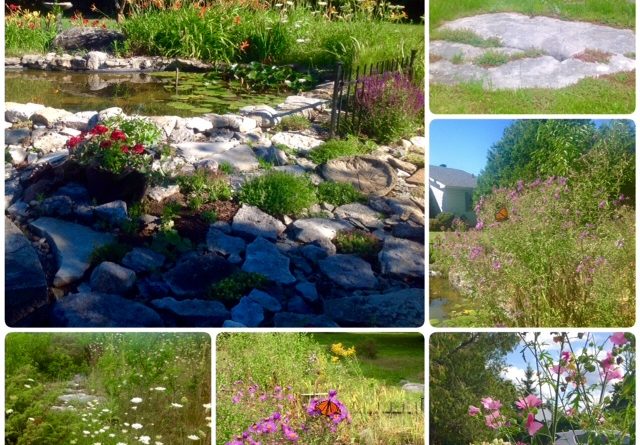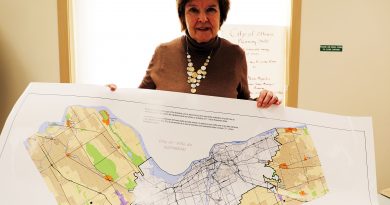Gadbois: Rewilding
It’s a trend. It’s been growing for a while (pun intended). It’s very 2020. What does it mean?

“Rewilding is large-scale conservation aimed at restoring and protecting natural processes and core wilderness areas, providing connectivity between such areas, and protecting or reintroducing apex predators and keystone species.” *
This wildlife conservation trend has spilled over into the gardening world throughout Europe. That is pretty understandable, since wild is not a state to be found much over there anymore. In England notably, it has taken off, with pristine lawns and fences being replaced by higher mown mixed-variety grasses, sedges and wildflowers, and by naturalized thickets and overgrown hedgerows. The aim is to provide diversity of habitat to entice wildlife back in to the garden and by wildlife, we mean birds, bees and other pollinating insects and also creatures of the furry kind.
In North America, we have a lot more untouched naturally wild terrain, but our urban and suburban lawns and gardens could do with a lot more diversity of plant material and insect species. A quick glance at most gardening magazines these days will attest to the rewilding trend here too. The compartmentalized and clipped is being replaced by free flowing and naturalistic design. Emphasis is now on ‘naturalizing’ by replacing highly cultivated plant choices with so called ‘natives.’
So, what is a native plant? For brevity’s sake, a native plant is one which has evolved in a certain location without our help. One of the best definitions I have found is the following from the U.S. National Wildlife Federation: “Native plants have formed symbiotic relationships with native wildlife over thousands of years, and therefore offer the most sustainable habitat. A plant is considered native if it has occurred naturally in a particular region, ecosystem, or habitat without human introduction.” **
If we walk into our own gardens here in West Carleton in the spring and take a look around at what does well, we might spot the ubiquitous dandelion and think it is a native plant. It is not, having been introduced by European migration. Conversely, the many varieties of asters in the fall apparently are considered a native plant to Canada and to some parts of the U.S.
We might think that because a plant grows too well here that it is a native but it often has been introduced, had thrived uncompeted and is now on our invasive list: e.g., purple loosestrife (native to Europe and Asia), garlic mustard (an invasive herb native to Europe) and ground covers like English ivy, periwinkle and goutweed (native to Europe and Asia). While invasive plants do attract pollinators – a good thing – they choke out other native species and that has a disastrous effect on the whole ecosystem sustaining those disappearing native varieties – a very bad thing.***
Our aim then in trying to recover some of the natural habitat for wildlife in our gardens is to reintroduce a balanced variety of plants, some of which may be real natives, in order to restore the balance of nature.
A number of measures to ‘rewild’ our gardens can be undertaken over time. We can:
- reclaim some of our lawn from turf grass monoculture by planting non-invasive species of groundcovers which flower and attract pollinators;
- leave those dandelions in place and simply mow them over, after all they only last a few weeks, but do provide precious early spring pollen for the bees;
- In and around our choice cultivars, encourage some native plants to help fill out our flower beds, e.g., Goldenrod, Asters, milkweed for monarchs, etc.;
- avoid planting invasive species;
- introduce a water feature, such as a pond or a rain garden (a bowl-shaped water-loving landscape feature which helps to reduce flooding);
- take a look at the surrounding area to see if our garden fits into it and design any changes to have it blend in more over time;
- put an end to harmful pesticides and herbicides;
- be tolerant of a bit of messiness—leave that pile of branches on the ground in a corner to provide cover for animals and insects.
Living in the rural countryside or in a town here in West Carleton, we are fortunate to have some pretty inspiring wilderness around us. From the Carp Ridge (“an island of Precambrian rock set in a sea of Paleozoic limestone”*****) to the fringes of the Burnt Lands Alvar with its rare vegetation, plants and insects, to the Ottawa River valley areas, we have diverse environments offering many opportunities to naturalize our gardens.
For those who may be interested in my personal quest to tackle the rewilding challenge, the following link might provide some ideas:
Of course, I chose to show some of the best pictures of the garden, and there are some dull spots at various times of the year, as it is always a work in progress. Overall, I’m pretty pumped about how the blending of the cultivated and the wild has progressed over time. By the way, rewilding does not mean less work, it requires maintenance just like for any other style of garden, but that labour is rewarded by a thriving ecosystem where birds, insects and animals come a-calling and plants can thrive.
If you are interested in hearing more about the value of naturalizing, come and visit us at the next meeting of the West Carleton Garden Club coming up on Tuesday, March 10, 7:30 to 9:30 p.m., Carp Memorial Hall, 3739 Carp Rd. Jeff Skevington will present a talk on Naturalist Gardens. More information: https://wcgc.ca/currentschedule.html
Sources
* https://en.wikipedia.org/wiki/Rewilding_(conservation_biology)
** https://www.nwf.org/Garden-for-Wildlife/About/Native-Plants
***https://www.ontario.ca/page/invasive-species-ontario and https://www.ontarioinvasiveplants.ca/wp-content/uploads/2020/01/GMI-Booklet_FINAL-FOR-WEB_May132016.pdf
****An amazing source of information about Ontario Wildflowers is available here: http://www.ontariowildflowers.com. and for Ontario trees, here: http://www.ontariotrees.com
*****Carp Hills: https://carphills.com/?page_id=92











